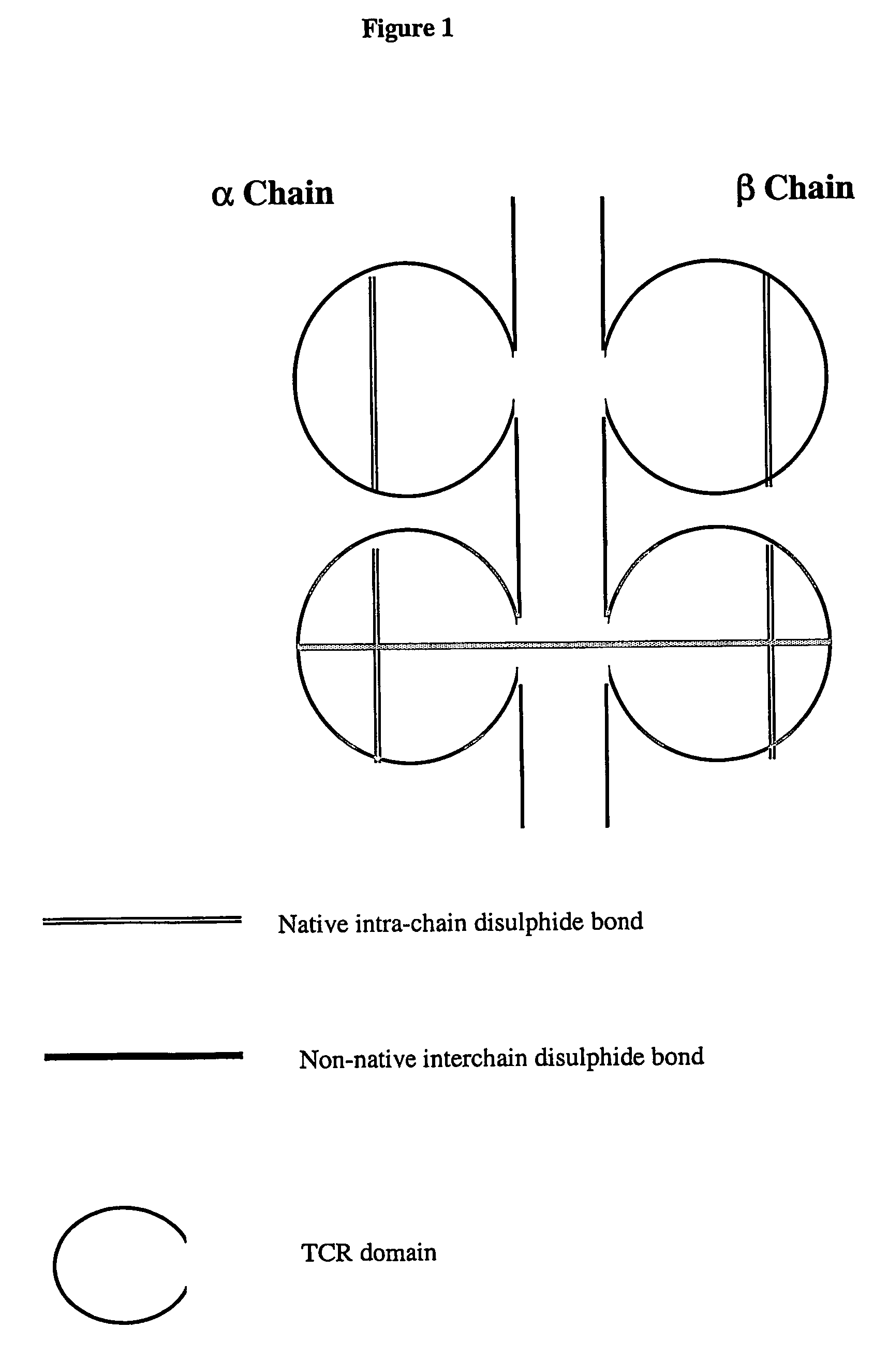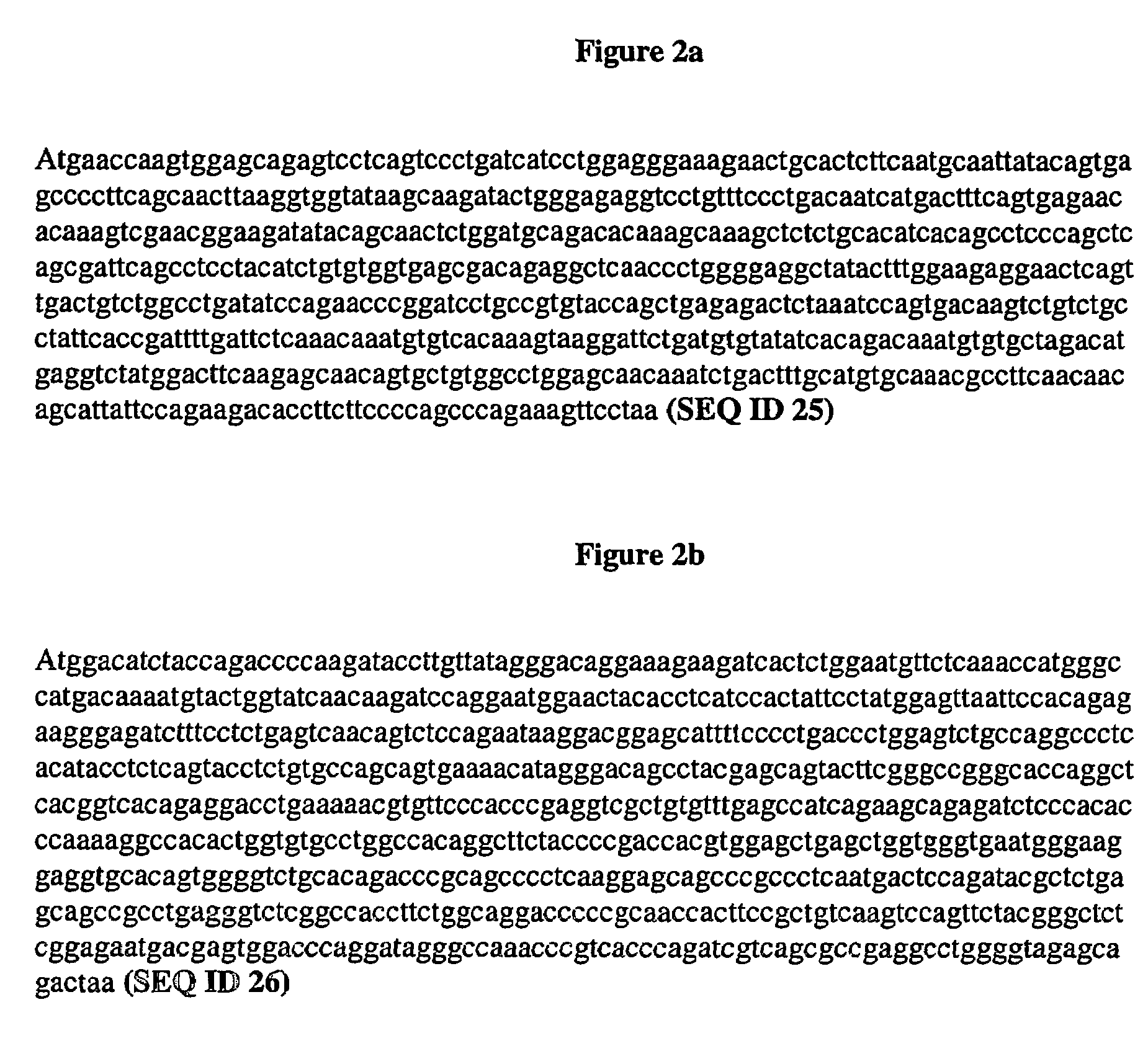Modified soluble T cell receptor
a t cell receptor and soluble technology, applied in the direction of peptides, drug compositions, immunological disorders, etc., can solve the problems of inability to recognise the native ligand at any other than relatively high concentrations, inability to identify appropriate sites, and inability to use techniques to identify appropriate sites
- Summary
- Abstract
- Description
- Claims
- Application Information
AI Technical Summary
Benefits of technology
Problems solved by technology
Method used
Image
Examples
example 1
Design of Primers and Mutagenesis of a CD1-Binding TCR α and β Chains
[0098]For mutating a CD1-binding TCR threonine 48 of exon 1 in TRAC*01 to cysteine, the following primers were designed (mutation shown in lower case):
[0099]
5′-C ACA GAC AAA tgT GTG CTA GAC AT(SEQ ID 21)5′-AT GTC TAG CAC Aca TTT GTC TGT G(SEQ ID 22)
[0100]For mutating CD1-binding TCR serine 57 of exon 1 in both TRBC1*01 and TRBC2*01 to cysteine, the following primers were designed (mutation shown in lower case):
[0101]
5′-C AGT GGG GTC tGC ACA GAC CC(SEQ ID 23)5′-GG GTC TGT GCa GAC CCC ACT G(SEQ ID 24)
[0102]PCR Mutagenesis:
[0103]Expression plasmids containing the genes for the CD1-binding TCR were obtained from cDNA isolated from a CD1 specific CD1 T cell clone. The TCR α or β chain were mutated using the α-chain primers or the β-chain primers respectively, as follows. 100 ng of plasmid was mixed with 5 μl 10 mM dNTP, 25 μl 10×Pfu-buffer (Stratagene), 10 units Pfu polymerase (Stratagene) and the final volume was adjus...
example 2
Expression, Refolding and Purification of Soluble TCR
[0104]The expression plasmids containing the mutated α-chain and β-chain respectively were transformed separately into E. coli strain BL21pLysS, and single ampicillin-resistant colonies were grown at 37° C. in TYP (ampicillin 100 μg / ml) medium to OD600 of 0.4 before inducing protein expression with 0.5 mM IPTG. Cells were harvested three hours post-induction by centrifugation for 30 minutes at 400 rpm in a Beckman J-6B. Cell pellets were re-suspended in a buffer containing 50 mM Tris-HCl, 25% (w / v) sucrose, 1 mM NaEDTA, 0.1% (w / v) NaAzide, 10 mM DTT, pH 8.0. After an overnight freeze-thaw step, re-suspended cells were sonicated in 1 minute bursts for a total of around 10 minutes in a Milsonix XL2020 sonicator using a standard 12 mm diameter probe. Inclusion body pellets were recovered by centrifugation for 30 minutes at 13000 rpm in a Beckman J2-21 centrifuge. Three detergent washes were then carried out to remove cell debris and ...
example 3
BIAcore Surface Plasmon Resonance Characterisation of sTCR Binding to CD1
[0108]A surface plasmon resonance biosensor (BIAcore 3000™ was used to analyse the binding of a sTCR to its CD1 ligand. This was facilitated by producing soluble CD1 complexes as described in (Bauer (1997) Eur J Immunol 27 (6) 1366-1373) which were immobilised to a streptavidin-coated binding surface in a semi-oriented fashion, allowing efficient testing of the binding of a soluble T-cell receptor to up to four different TCR ligands (immobilised on separate flow cells) simultaneously. Manual injection of HLA complex allows the precise level of immobilised TCR ligand to be manipulated easily.
[0109]Such immobilised complexes are capable of binding both T-cell receptors and the coreceptor CD8αα both of which may be injected in the soluble phase. Specific binding of TCR is obtained even at low concentrations (at least 40 μg / ml), implying the TCR is relatively stable. The CD1 binding binding properties of sTCR are o...
PUM
| Property | Measurement | Unit |
|---|---|---|
| concentration | aaaaa | aaaaa |
| molecular weight | aaaaa | aaaaa |
| diameter | aaaaa | aaaaa |
Abstract
Description
Claims
Application Information
 Login to View More
Login to View More - R&D
- Intellectual Property
- Life Sciences
- Materials
- Tech Scout
- Unparalleled Data Quality
- Higher Quality Content
- 60% Fewer Hallucinations
Browse by: Latest US Patents, China's latest patents, Technical Efficacy Thesaurus, Application Domain, Technology Topic, Popular Technical Reports.
© 2025 PatSnap. All rights reserved.Legal|Privacy policy|Modern Slavery Act Transparency Statement|Sitemap|About US| Contact US: help@patsnap.com



